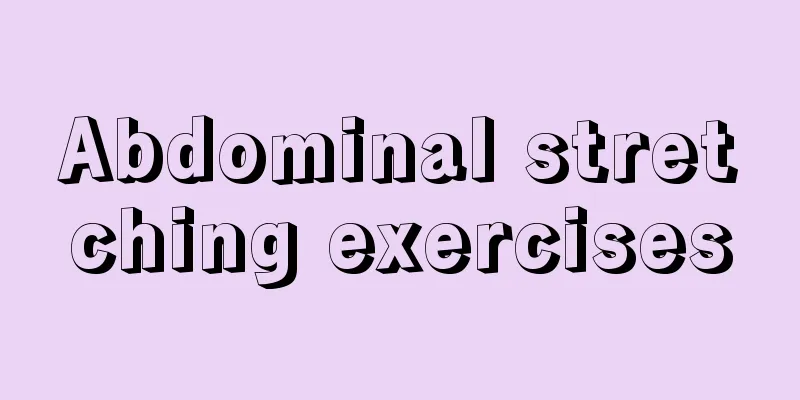Abdominal stretching exercises

|
A proper warm-up is essential to preventing injuries in an effective exercise program. Warming up exercises keep the muscles fully active and more supple when they contract, which is necessary during core exercises. It's a good idea to slightly raise your body temperature and increase your heart rate during stretching. This is where stretching should be prioritized so your muscles are ready for practice without you having to do it. Do 5 to 10 minutes of cardiovascular conditioning exercise to meet this requirement. 1. Stretch the rectus abdominis The rectus abdominis is located on both sides of the midline of the anterior abdominal wall, within the rectus sheath. It is a band-shaped multi-abdominal muscle that is wide at the top and narrow at the bottom. It originates from the pubic symphysis and pubic crest, and the muscle fibers end at the xiphoid process of the sternum and the front of the 5th to 7th costal cartilages. The entire length of the muscle is divided into multiple muscle bellies by 3 to 4 transverse tendons. The average length is 26cm, the midpoint width is 8cm. When contracted, it causes the spine to flex forward and tighten the abdominal wall, receiving nutrition from the superior epigastric artery and the inferior epigastric artery. The inferior epigastric artery branches off from the external iliac artery above the inguinal ligament, and two veins run along it, running inward and upward, entering the rectus abdominis from the outer edge of the rectus abdominis at the arcuate margin, running between the rectus abdominis and the posterior sheath, ascending to the umbilicus to form terminal branches, and forming extensive communicating branches around the umbilicus with the terminal branches of the superior epigastric artery coming from the upper end of the rectus abdominis. The function of the anterolateral abdominal muscles is to protect the abdominal organs and maintain intra-abdominal pressure; they are involved in completing physiological functions such as defecation, childbirth, vomiting and coughing; they can lower the ribs to assist exhalation, and can also flex, flex and rotate the spine. 2. Stretch the quadratus lumborum The quadratus lumborum muscle is located on the posterior abdominal wall, on both sides of the spine, with the psoas major muscle on the inside and the erector spinae muscle on the back. The middle layer of the thoracolumbar fascia separates the two, starting from the lower edge of the 12th rib and the posterior part of the iliac crest of the transverse processes of the 1st to 4th lumbar vertebrae, and ending at the upper edge of the iliac crest. Function: Descends and fixes the 12th rib and lateralizes the spine. Innervated by the anterior rami of the lumbar nerve. This muscle is very important in treating low back pain. 2.3 Stretch the iliopsoas muscle The iliopsoas muscle is composed of the iliacus and psoas major muscles. The iliacus muscle is fan-shaped and originates from the iliac fossa; the psoas major muscle is long and originates from the sides and transverse processes of the lumbar vertebrae. The two muscles merge downwards, pass deep to the inguinal ligament, and insert at the lesser trochanter of the femur. 3. 4 Quadriceps stretch The thigh muscles include the quadriceps femoris in the front, the biceps femoris in the back, and the sartorius muscle and adductor magnus muscle on the inside. To make your thighs strong, you must first develop your quadriceps, because the quadriceps are one of the largest and most powerful muscles in the human body. It consists of four heads, the rectus femoris, vastus intermedius, vastus lateralis and vastus medialis, and the tendons form the largest sesamoid bone in the human body - the patella and the patellar ligament. The function of the quadriceps is to extend the calf, extend and flex the thigh, extend the knee (joint) and flex the hip (joint), and maintain the body's upright posture. 4.5 Stretch the adductor vastus The adductor vastus muscles are located on the inner side of the femur. There are five of them, arranged in three layers. The superficial layer has the pectineus muscle on the outside, the adductor longus muscle on the inside, and the gracilis muscle on the innermost posterior surface. 5. 6 Gluteus maximus and piriformis stretch The gluteus maximus is slightly quadrilateral, originating from the back of the ilium, sacrum, coccyx and sacrotuberous ligament. The muscle bundles slant downward and outward, crossing the back of the hip joint with a thick tendon plate, and ending at the gluteal tuberosity and iliotibial band. The piriformis muscle originates from the front of the 2nd, 3rd, and 4th sacral vertebrae, is distributed on the inner surface of the small pelvis, enters the buttocks through the greater sciatic foramen, and ends at the back of the greater trochanter of the femur. The internal iliac artery is divided into the superior gluteal artery and the inferior gluteal artery, which pass through the superior and inferior foramina of the piriformis muscle respectively to the buttocks, and branches nourish the gluteal muscles and iliac joints. 6. 7 Gastrocnemius stretch The large superficial muscle at the back of the calf is commonly known as the calf. The lower end of the muscle forms a tough calcaneus that connects to the calcaneus bone. 7. 8 Stretch the soleus muscle The flat calf muscle below the gastrocnemius originates from the back of the upper end of the tibia and fibula. It is named soleus muscle because it resembles a soleus. It is collectively called the triceps surae along with the gastrocnemius. |
<<: Will kidney deficiency cause headaches?
>>: How to lose weight with belly fat
Recommend
What material is good for underwear?
We wear underwear every day, no matter whether we...
The efficacy and function of albumin injection
Albumin in our body is the main source of our nut...
Can I eat soft-shelled turtles in the late stage of liver cancer? Five points to note when eating soft-shelled turtles in the late stage of liver cancer
Turtle is a common animal in life and is also a c...
How to treat advanced lung cancer effectively? Inventory of treatment methods for advanced lung cancer
I believe everyone is familiar with lung cancer. ...
The dangers of taking a cold shower after exercise
Nowadays, more and more people like sports. Many ...
What foods lower LDL cholesterol?
Foods with high cholesterol content can easily le...
What should you pay attention to when doing manicure
Nowadays, many women pay attention to their image...
There are many small black spots on my body
Some people suddenly find that they have many sma...
Is grade one brown sugar better or grade two brown sugar?
Brown sugar is divided into several grades, and e...
Do you know what types of benign skin tumors there are?
Benign skin tumors refer to skin diseases that gr...
What are the layers of the skin's epidermis?
The skin is an important barrier of the human bod...
Lazy people’s laundry skills
Although every household has a washing machine no...
Will urethral injury and bleeding heal on its own?
Urethral injury is a very common disease. There a...
Five factors that cause pancreatic cancer
Pancreatic cancer is a very common digestive trac...
What are the methods for diagnosing bladder cancer? Is drinking tap water related to bladder cancer?
To ensure hygiene, most tap water is now disinfec...









